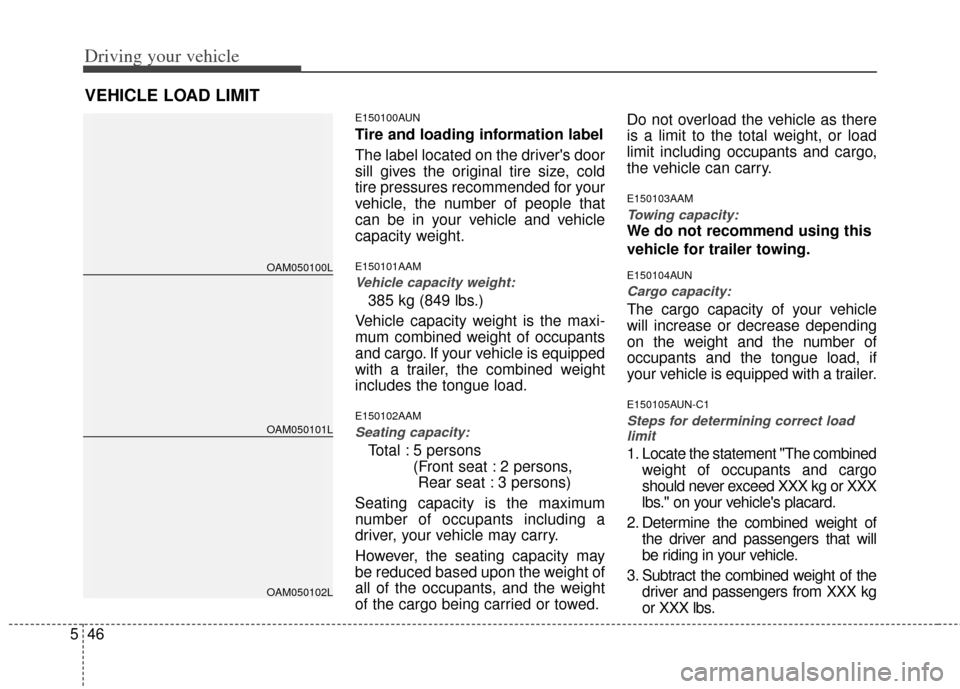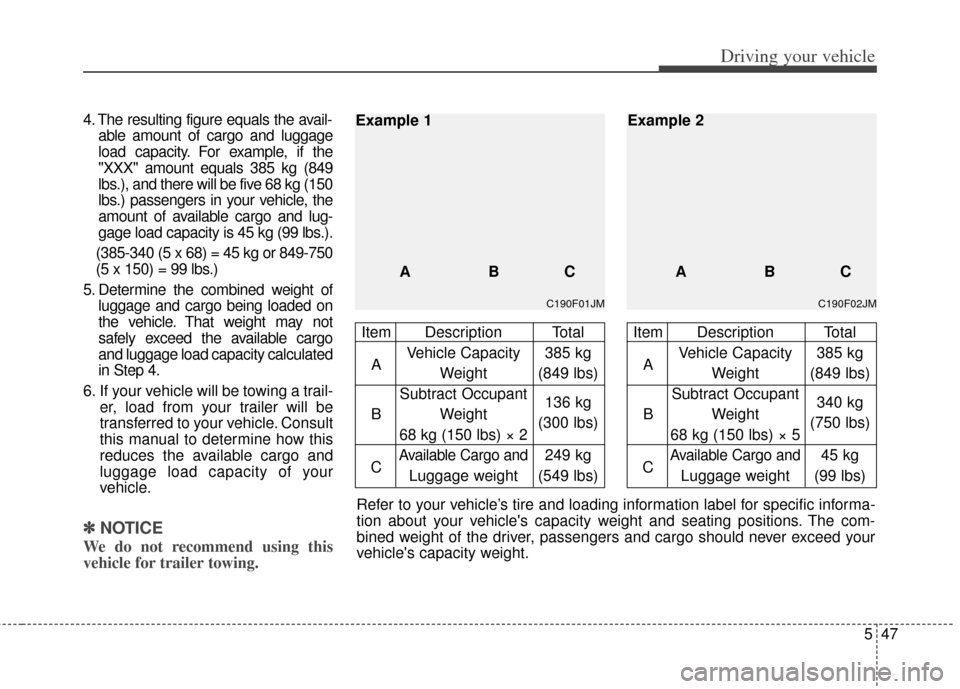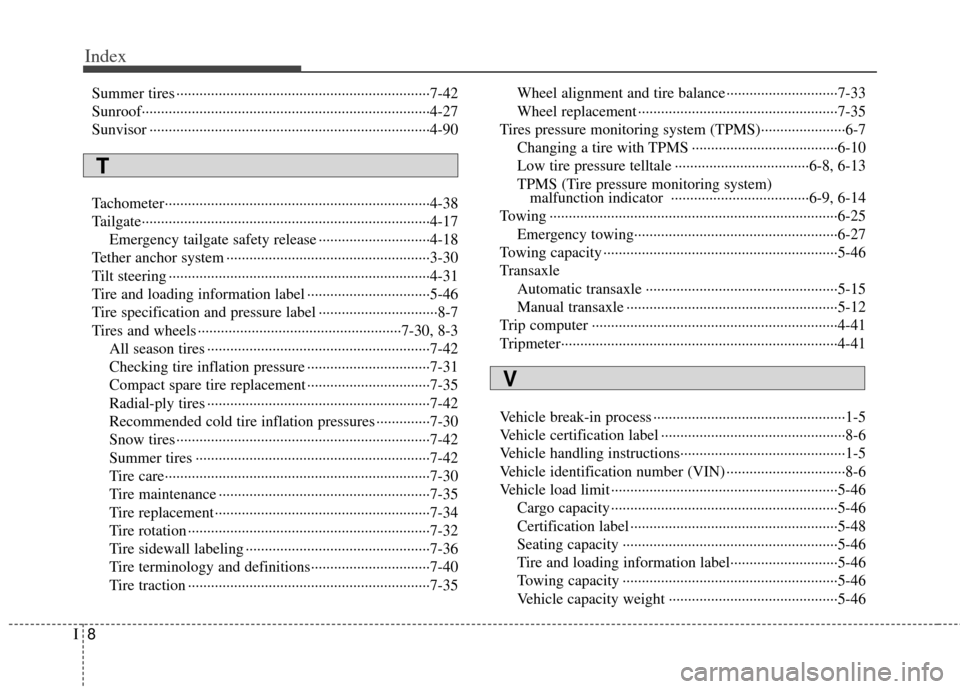2011 KIA Soul towing capacity
[x] Cancel search: towing capacityPage 247 of 356

Driving your vehicle
46
5
E150100AUN
Tire and loading information label
The label located on the driver's door
sill gives the original tire size, cold
tire pressures recommended for your
vehicle, the number of people that
can be in your vehicle and vehicle
capacity weight.
E150101AAM
Vehicle capacity weight:
385 kg (849 lbs.)
Vehicle capacity weight is the maxi-
mum combined weight of occupants
and cargo. If your vehicle is equipped
with a trailer, the combined weight
includes the tongue load.
E150102AAM
Seating capacity:
Total : 5 persons (Front seat : 2 persons, Rear seat : 3 persons)
Seating capacity is the maximum
number of occupants including a
driver, your vehicle may carry.
However, the seating capacity may
be reduced based upon the weight of
all of the occupants, and the weight
of the cargo being carried or towed. Do not overload the vehicle as there
is a limit to the total weight, or load
limit including occupants and cargo,
the vehicle can carry.
E150103AAM
Towing capacity:
We do not recommend using this
vehicle for trailer towing.
E150104AUN
Cargo capacity:
The cargo capacity of your vehicle
will increase or decrease depending
on the weight and the number of
occupants and the tongue load, if
your vehicle is equipped with a trailer.
E150105AUN-C1
Steps for determining correct load
limit
1. Locate the statement "The combined weight of occupants and cargo
should never exceed XXX kg or XXX
lbs.'' on your vehicle's placard.
2. Determine the combined weight of the driver and passengers that will
be riding in your vehicle.
3. Subtract the combined weight of the driver and passengers from XXX kg
or XXX lbs.
VEHICLE LOAD LIMIT
OAM050100L
OAM050101L
OAM050102L
Page 248 of 356

547
Driving your vehicle
4. The resulting figure equals the avail-able amount of cargo and luggage
load capacity. For example, if the
"XXX" amount equals 385 kg (849
lbs.), and there will be five 68 kg (150
lbs.) passengers in your vehicle, the
amount of available cargo and lug-
gage load capacity is 45 kg (99 lbs.).
(385-340 (5 x 68) = 45 kg or 849-750
(5 x 150) = 99 lbs.)
5. Determine the combined weight of luggage and cargo being loaded on
the vehicle. That weight may not
safely exceed the available cargo
and luggage load capacity calculated
in Step 4.
6. If your vehicle will be towing a trail- er, load from your trailer will be
transferred to your vehicle. Consult
this manual to determine how this
reduces the available cargo and
luggage load capacity of your
vehicle.
✽ ✽NOTICE
We do not recommend using this
vehicle for trailer towing.
Refer to your vehicle’s tire and loading information label for specific informa-
tion about your vehicle's capacity weight and seating positions. The com-
bined weight of the driver, passengers and cargo should never exceed your
vehicle's capacity weight.
C190F01JM
Item Description Total
A Vehicle Capacity 385 kg
Weight (849 lbs)
Subtract Occupant
B Weight 136 kg
68 kg (150 lbs) × 2 (300 lbs)
C
Available Cargo and249 kg
Luggage weight (549 lbs)
Example 1
ABC
C190F02JM
Item Description TotalA Vehicle Capacity 385 kg
Weight (849 lbs)
Subtract Occupant
B Weight 340 kg
68 kg (150 lbs) × 5 (750 lbs)
C
Available Cargo and45 kg
Luggage weight (99 lbs)
ABC
Example 2
Page 355 of 356

Index
8I
Summer tires ··················\
··················\
··················\
············7-42
Sunroof··················\
··················\
··················\
··················\
···4-27
Sunvisor ··················\
··················\
··················\
··················\
·4-90
Tachometer··················\
··················\
··················\
···············4-38
Tailgate··················\
··················\
··················\
··················\
···4-17Emergency tailgate safety release ··················\
···········4-18
Tether anchor system ··················\
··················\
·················3-30\
Tilt steering ··················\
··················\
··················\
··············4-31
Tire and loading information label ··················\
··············5-46
Tire specification and pressure label ··················\
·············8-7
Tires and wheels ··················\
··················\
·················7-30\
, 8-3 All season tires ··················\
··················\
··················\
····7-42
Checking tire inflation pressure ··················\
··············7-31
Compact spare tire replacement ··················\
··············7-35
Radial-ply tires ··················\
··················\
··················\
····7-42
Recommended cold tire inflation pressures ··············7-30
Snow tires ··················\
··················\
··················\
············7-42
Summer tires ··················\
··················\
··················\
·······7-42
Tire care··················\
··················\
··················\
···············7-30
Tire maintenance ··················\
··················\
··················\
·7-35
Tire replacement ··················\
··················\
··················\
··7-34
Tire rotation ··················\
··················\
··················\
·········7-32
Tire sidewall labeling ··················\
··················\
············7-36
Tire terminology and definitions··················\
·············7-40
Tire traction ··················\
··················\
··················\
·········7-35 Wheel alignment and tire balance ··················\
···········7-33
Wheel replacement ··················\
··················\
················7-35
Tires pressure monitoring system (TPMS)··················\
····6-7 Changing a tire with TPMS ··················\
··················\
··6-10
Low tire pressure telltale ··················\
·················6-8,\
6-13
TPMS (Tire pressure monitoring system) malfunction indicator ··················\
··················\
6-9, 6-14
Towing ··················\
··················\
··················\
··················\
···6-25 Emergency towing··················\
··················\
·················6-27\
Towing capacity ··················\
··················\
··················\
·······5-46
Transaxle Automatic transaxle ··················\
··················\
··············5-15
Manual transaxle ··················\
··················\
··················\
·5-12
Trip computer ··················\
··················\
··················\
··········4-41
Tripmeter··················\
··················\
··················\
··················\
4-41
Vehicle break-in process ··················\
··················\
··············1-5
Vehicle certification label ··················\
··················\
············8-6
Vehicle handling instructions··················\
··················\
·······1-5
Vehicle identification number (VIN) ··················\
·············8-6
Vehicle load limit ··················\
··················\
··················\
·····5-46 Cargo capacity ··················\
··················\
··················\
·····5-46
Certification label ··················\
··················\
··················\
5-48
Seating capacity ··················\
··················\
··················\
··5-46
Tire and loading information label··················\
··········5-46
Towing capacity ··················\
··················\
··················\
··5-46
Vehicle capacity weight ··················\
··················\
········5-46
T
V